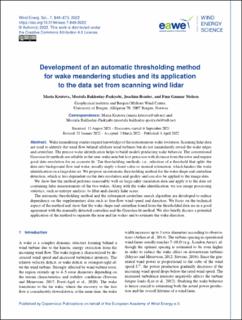| dc.contributor.author | Krutova, Maria | |
| dc.contributor.author | Paskyabi, Mostafa Bakhoday | |
| dc.contributor.author | Reuder, Joachim | |
| dc.contributor.author | Nielsen, Finn Gunnar | |
| dc.date.accessioned | 2022-05-02T10:49:23Z | |
| dc.date.available | 2022-05-02T10:49:23Z | |
| dc.date.created | 2022-04-27T09:58:11Z | |
| dc.date.issued | 2022 | |
| dc.identifier.issn | 2366-7443 | |
| dc.identifier.uri | https://hdl.handle.net/11250/2993616 | |
| dc.description.abstract | Wake meandering studies require knowledge of the instantaneous wake evolution. Scanning lidar data are used to identify the wind flow behind offshore wind turbines but do not immediately reveal the wake edges and centerline. The precise wake identification helps to build models predicting wake behavior. The conventional Gaussian fit methods are reliable in the near-wake area but lose precision with distance from the rotor and require good data resolution for an accurate fit. The thresholding methods, i.e., selection of a threshold that splits the data into background flow and wake, usually imply a fixed value or manual estimation, which hinders the wake identification on a large data set. We propose an automatic thresholding method for the wake shape and centerline detection, which is less dependent on the data resolution and quality and can also be applied to the image data.
We show that the method performs reasonably well on large-eddy simulation data and apply it to the data set containing lidar measurements of the two wakes. Along with the wake identification, we use image processing statistics, such as entropy analysis, to filter and classify lidar scans.
The automatic thresholding method and the subsequent centerline search algorithm are developed to reduce dependency on the supplementary data such as free-flow wind speed and direction. We focus on the technical aspect of the method and show that the wake shape and centerline found from the thresholded data are in a good agreement with the manually detected centerline and the Gaussian fit method. We also briefly discuss a potential application of the method to separate the near and far wakes and to estimate the wake direction. | en_US |
| dc.language.iso | eng | en_US |
| dc.publisher | Copernicus Publications | en_US |
| dc.rights | Navngivelse 4.0 Internasjonal | * |
| dc.rights.uri | http://creativecommons.org/licenses/by/4.0/deed.no | * |
| dc.subject | Bildebehandling | en_US |
| dc.subject | Image processing | en_US |
| dc.subject | Vindturbiner kjølvannet | en_US |
| dc.subject | Wind turbine wake | en_US |
| dc.title | Development of an automatic thresholding method for wake meandering studies and its application to the data set from scanning wind lidar | en_US |
| dc.type | Journal article | en_US |
| dc.type | Peer reviewed | en_US |
| dc.description.version | publishedVersion | en_US |
| dc.rights.holder | Copyright 2022 The Author(s) | en_US |
| cristin.ispublished | true | |
| cristin.fulltext | postprint | |
| cristin.qualitycode | 1 | |
| dc.identifier.doi | 10.5194/wes-7-849-2022 | |
| dc.identifier.cristin | 2019376 | |
| dc.source.journal | Wind Energy Science | en_US |
| dc.source.pagenumber | 849-873 | en_US |
| dc.subject.nsi | VDP::Matematikk og naturvitenskap: 400 | en_US |
| dc.subject.nsi | VDP::Mathematics and natural scienses: 400 | en_US |
| dc.identifier.citation | Wind Energy Science. 2022, 7, 849-873. | en_US |
| dc.source.volume | 7 | en_US |

